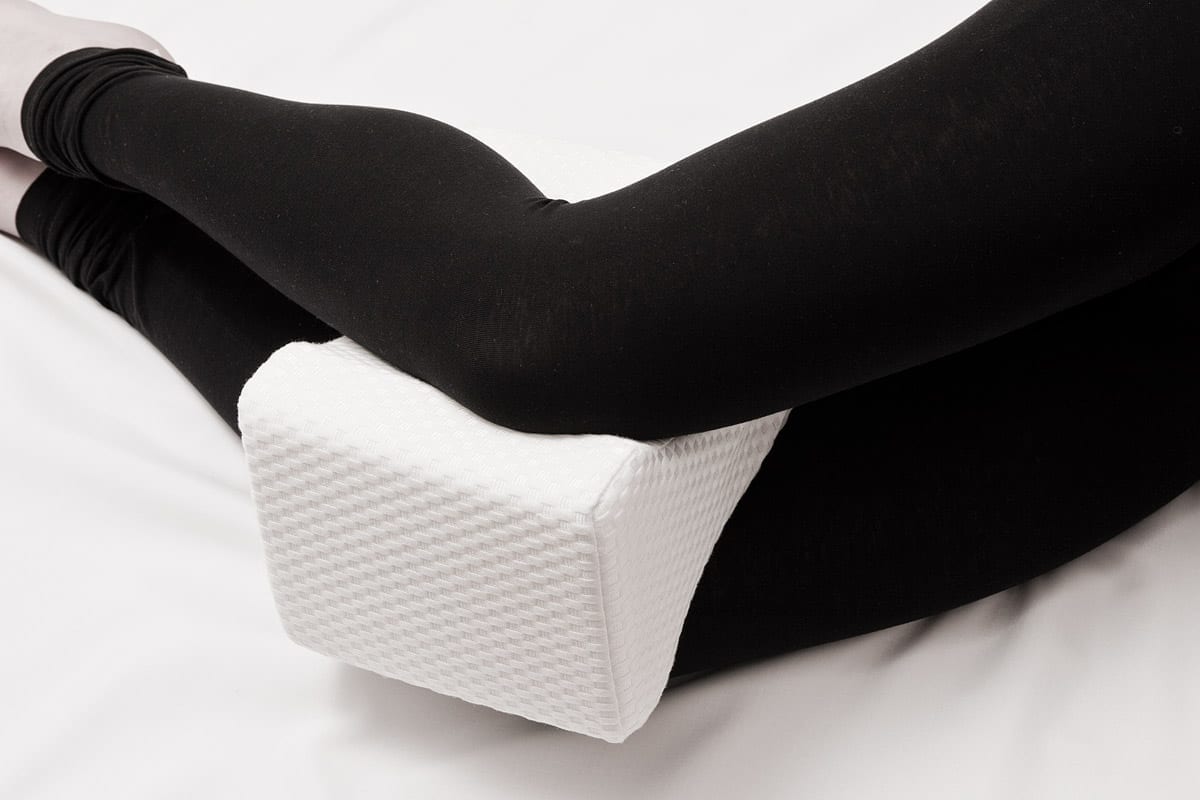Do you ever wake up and immediately feel like you’ve got hay fever? Regardless of the time of year, this can get frustrating. While we immediately look outside and blame nature, this may not actually be the case. Even as the weather changes, do you get the same symptoms? The cause is probably closer to home, and it is dust mites.
We may have to make your skin itch slightly, because dust mites are found all over the home. Feeding off our dead skin cells, they tend to frequent soft surfaces such as curtains, rugs, sofas, and beds. Suddenly, we’re sneezing every three seconds, our nose is blocked, we’re coughing, experiencing post nasal drip, and have itchy eyes.
How do we tell apart hay fever from dust mite allergies? Well, one way is to consider when the symptoms arise. If you go to bed feeling fine and then wake up feeling terrible, this suggests something happened while you were sleeping. Unfortunately, it’s our pillows that are the most common sources of exposure. With this in mind, it’s not surprising we wake up feeling awful after several hours of direct contact.
What’s the solution? These days, there are some fantastic manufacturers who produce pillows and bedding designed to help those with allergies. By using plant-based fibers and other hypoallergenic fabrics, we can sleep without concern and wake up with more energy than ever before. Some fabrics are naturally hypoallergenic, and this includes;
- Linen
- Cotton
- Silk
Meanwhile, even synthetic materials can be hypoallergenic when treated with additives. This includes;
- Rayon (from bamboo)
- Polyester
As well as helping with dust mites, hypoallergenic pillows have the added bonus of assisting with mildew and mold too. In this guide, we’re going to discover everything you need to know about these products. You’ll learn the best brands, different types, important considerations, importance of sleeping positions, and more!
Table of Contents
The research done on this website is made possible by commissions earned through sales from affiliate links shared within the content. Learn more here.
The Best Hypoallergenic Pillows of 2020
Picture | Product | Key Features | Price |
|---|---|---|---|
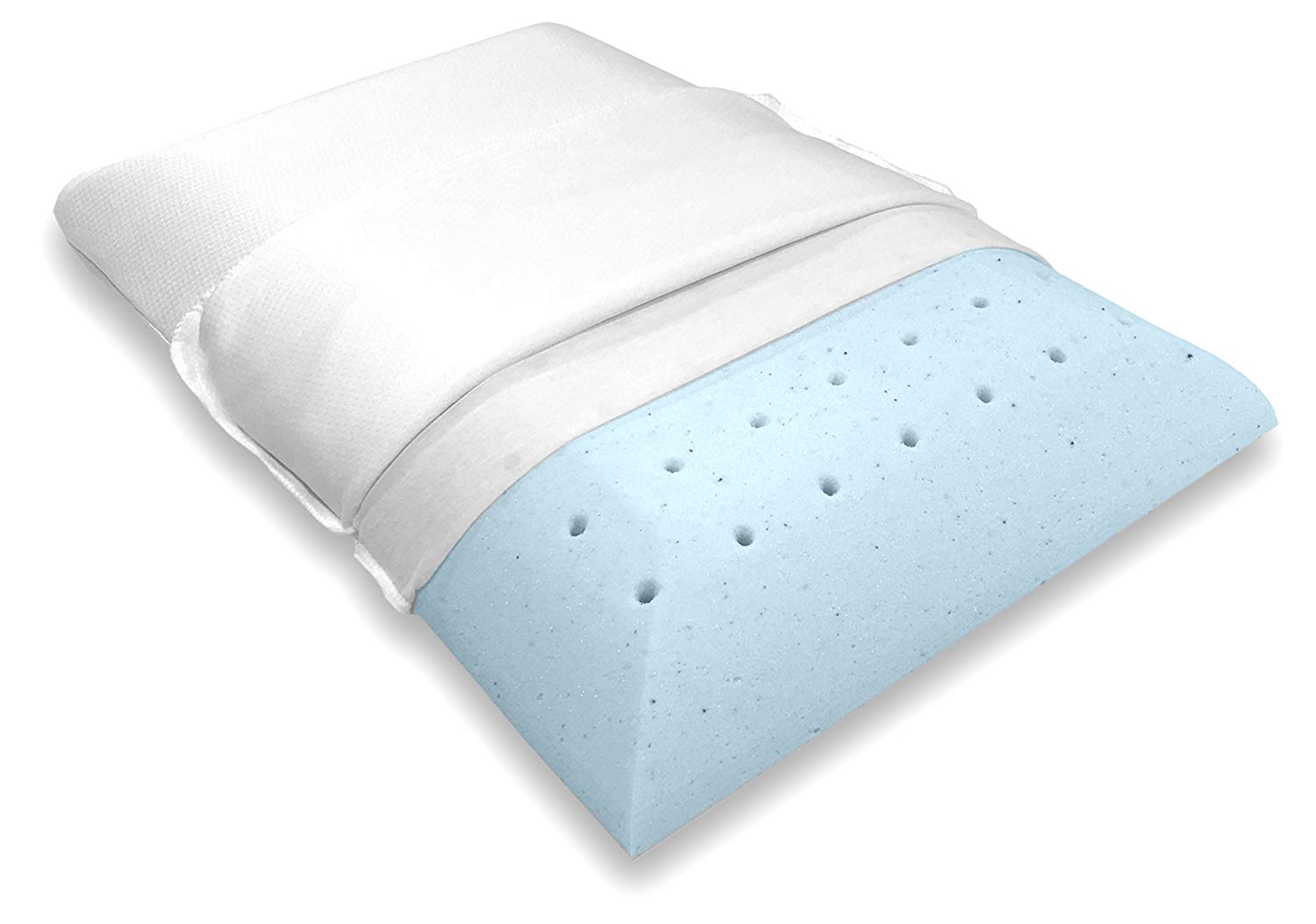 | - Hidden zipper to add/remove filling | ||
 | - Affordable | ||
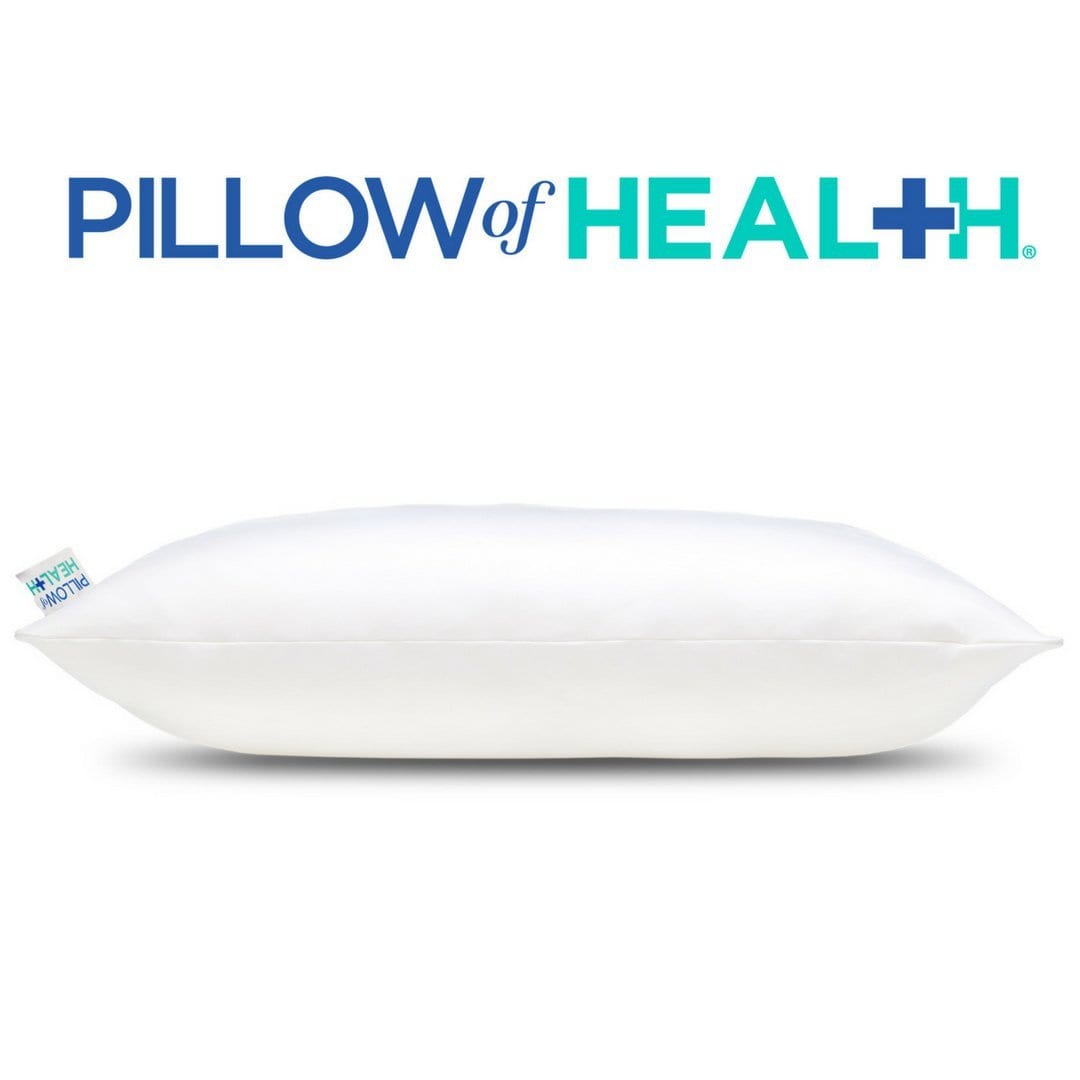 | - Not too fluffy | ||
 | - Available in a pack of two | ||
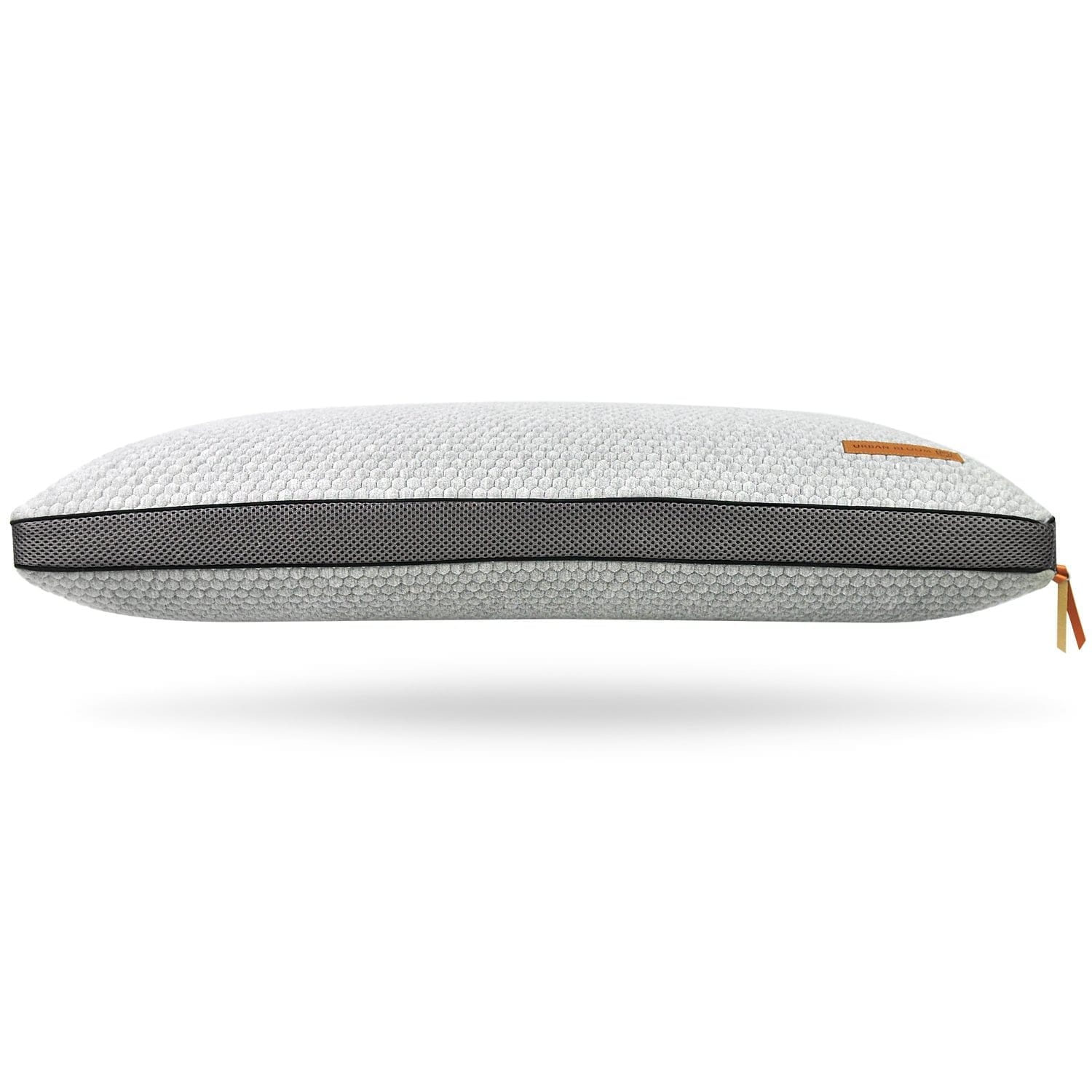 | - Memory foam comfort | ||
 | - Removable pillowcase | ||
 | - Memory foam filling | ||
 | - Contains no harmful substances | ||
 | - Dust mite resistant and hypoallergenic | ||
 | - Sleeps cool |
Foamily Premium Hypoallergenic European Sleep Pillow Review
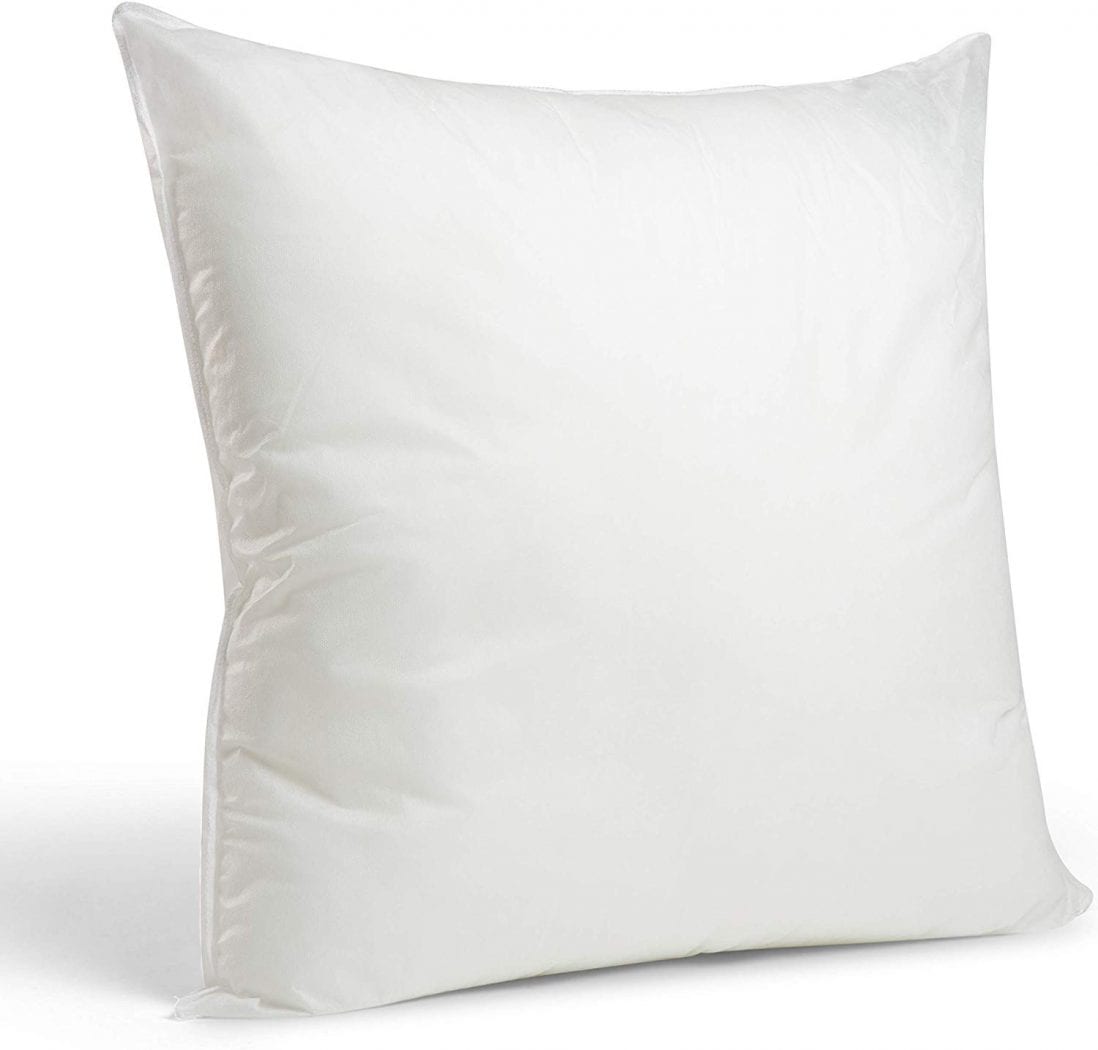
- Hidden zipper to add/remove filling
- Ideal size for throw pillows on sofa or bed
- Soft and supportive polyester fiber
Price:
As our first product review in this guide, we have the Foamily Premium Hypoallergenic European Sleep Pillow. Using a high-grade fiber filling unique to the brand, it’s a great way to add to your comfortable lounge chair, bed, sofa, or wherever else you like to rest. Measuring 26x26 inches, it can be a decorative piece before then transforming into a supportive pillow for when you’re reading, watching TV, or just lounging.
We love the hypoallergenic polyester fiber because it manages to combine support for the lower back with overall comfort. Thanks to the hidden zipper, you can also add/remove filling to find a balance that suits you. Since it will be used in the living room, we should note that there are several patterns and colors. Why not find one that matches the style of your room?
Duro-Med U Shaped Contour Body Pillow Review
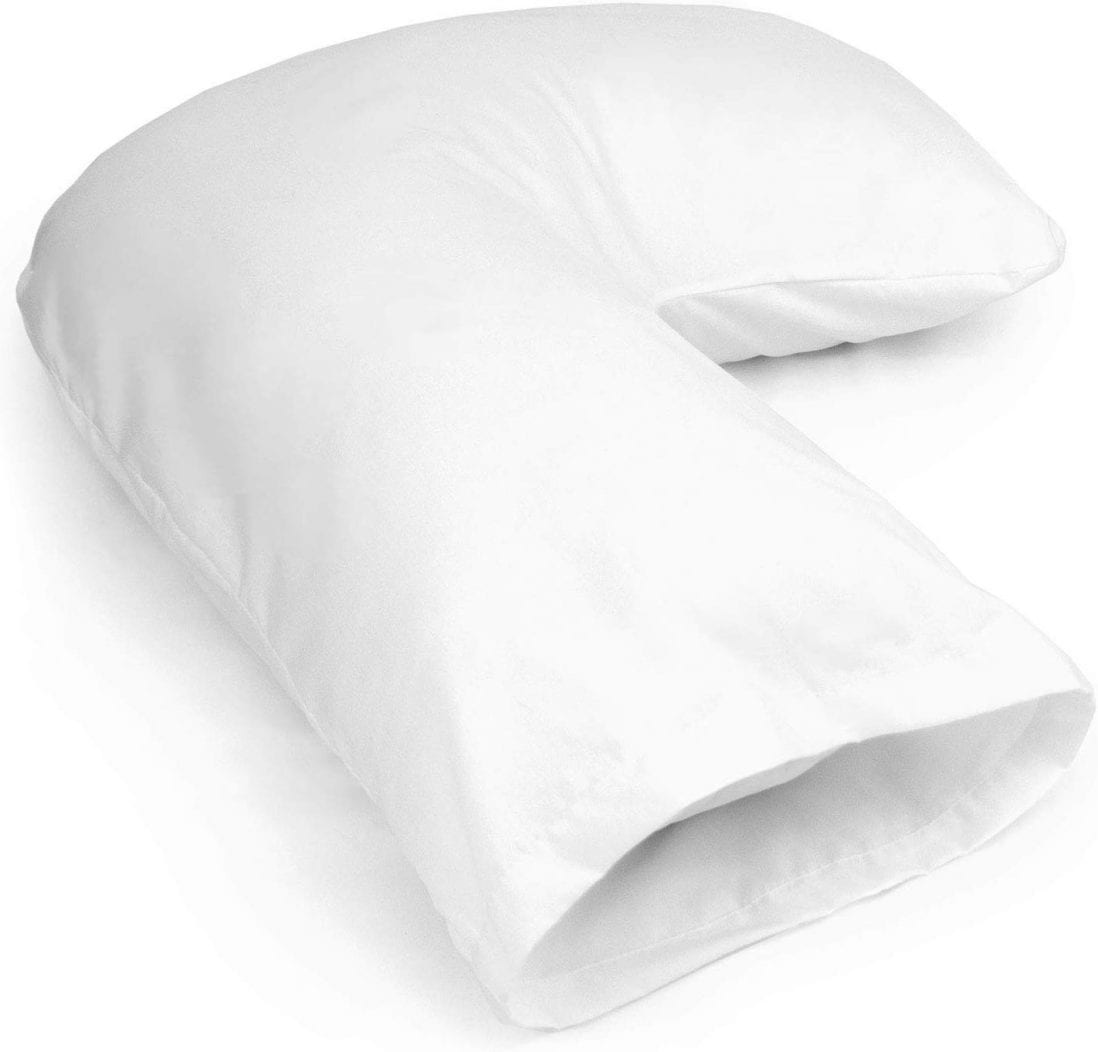
- Affordable
- Orthopedic pillow with an ‘L’ shape
- Small design (fits on all beds)
Price:
Often, standard pillows lack spinal alignment, and this leads to shoulder and neck pain. With an orthopedic pillow, like the Duro-Med U Shaped Contour Body Pillow, you can sleep on your side and the pillow around the front of your body. While one arm rests on the L shape, the rest of the pillow goes under the neck, and this has two benefits;
The neck has more support
The shoulders aren’t strained
In truth, we believe the Duro-Med U Shaped Contour Body Pillow can mold to all sleepers because it can cushion you through all sorts of movement. In terms of the product itself, it will keep its shape as a result of high-quality materials and clever manufacturing. It’s a different shape to traditional pillows, and this might cause some nerves, but it’s actually only 17x22 inches. With this in mind, it doesn’t take huge amounts of space.
Made of poly-cotton, the cover is removable and washable (which is always a bonus!). Of course, we also shouldn’t forget that it costs just under $20. It’s one of the most affordable hypoallergenic pillows and is well worth the risk.
Dreamtown Kids Toddler Pillow Review
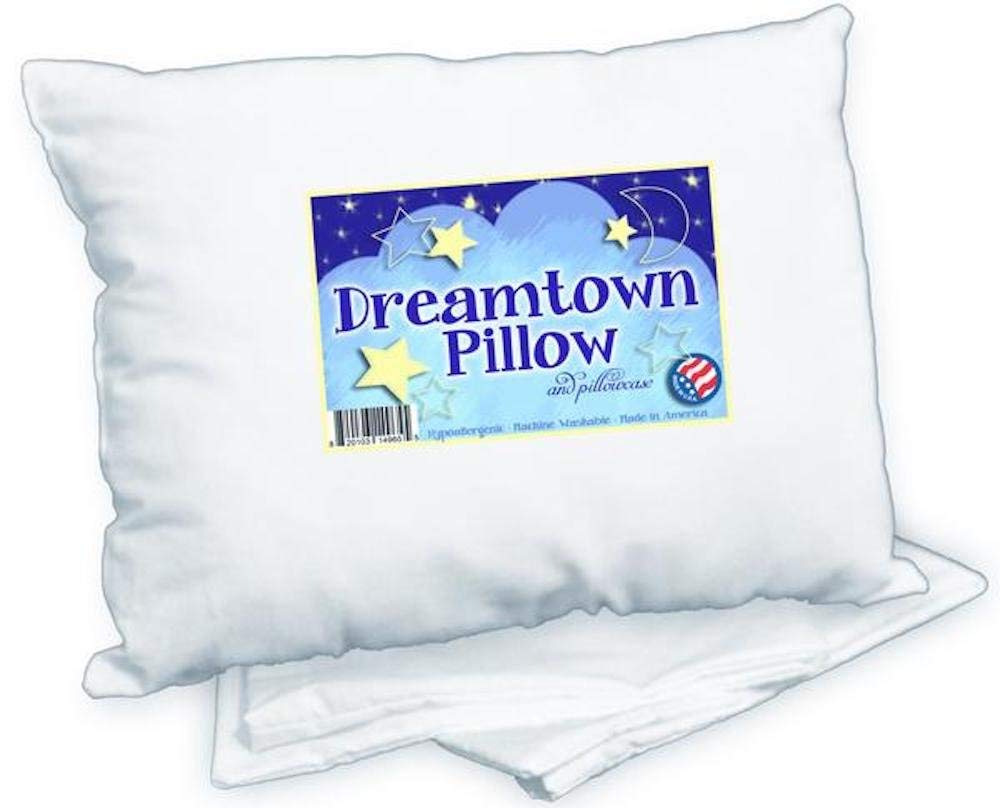
- Not too fluffy
- Ideal for both children and toddlers
- Resistant to mildew and mold, hypoallergenic
Price:
We take great care in keeping our children’s clothing soft and safe, but what about their bedding? Often, pillows are something we take for granted. Well, this is no longer the case since the Dreamtown Kids Toddler PIllow is an ideal hypoallergenic pillow for children. It’s resistant to mold and mildew, and is even recommended by chiropractors. Measuring at 14x19 inches, you can put your child to bed with peace of mind.
Although not suitable for children under two years of age, it will work for those older, and the fact that it isn’t too fluffy means that your child shouldn’t experience kinks in the neck. Made in the US, it utilizes a poly/cotton blend and gets softer as it’s washed. If you travel and like small pillows, there’s also no reason why you can’t use it as an adult.
Zen Bamboo Ultra Plush Gel Pillow (2-Pack) Review

- Available in a pack of two
- Hypoallergenic, chemical-free, resistant against mold and mildew
- Cool and breathable cover
Price:
If you sleep hot, you might be looking for a combination of hypoallergenic and cool with your pillow, and the answer comes with the Zen Bamboo Ultra Plush Gel Pillow (2-Pack). Firstly, the plush gel fiber inside is hypoallergenic, resistant against mold and mildew, and free from chemicals. If you experience allergies, asthma, or another respiratory problem, this will be the perfect partner.
In terms of the cover, the material is a jacquard bamboo, which means you stay cool and also feel comfortable on the soft surface. It’s designed with no-shift construction, ensuring that you always get support too.
If the Zen Bamboo Ultra Plush Gel Pillow (2-Pack) starts to smell, throw it in the machine; we should note that the fabric is both stain and fade resistant. If you require two pillows, the manufacturer does offer multipacks as well as having both Queen and King sizes. If you enjoy this hypoallergenic pillow and want to take it further, Zen Bamboo also offers a hypoallergenic mattress cover.
Lofe Gel Infused Memory Foam Pillow Review
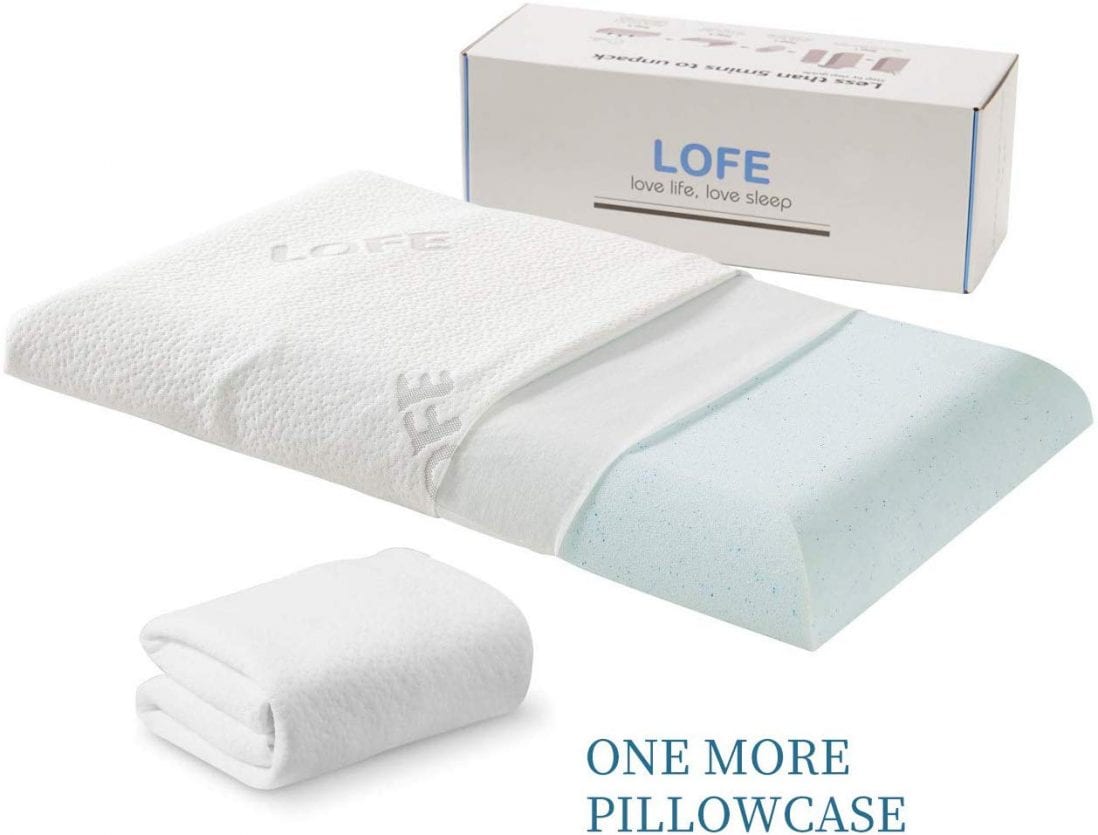
- Memory foam comfort
- Thin design is ideal for stomach sleepers
- Antibacterial, hypoallergenic, resistant to bed bugs
Price:
The Lofe Gel Infused Memory Foam Pillow is ideal for stomach sleepers because it measures just 2.5 inches in thickness. As stomach sleepers will know, regular pillows can cause pain in the shoulder and neck because the head is pushed higher than the rest of the body at an awkward angle. With the Lofe, the head is kept in line with the spine, and you should sleep more comfortably. Additionally, breathing improves with the head and neck rotation reduction thanks to ergonomic edges.
Often, people think thin pillows lack support, but this isn’t the case. The Lofe Gel Infused Memory Foam Pillow contains memory foam, which means you get the comfort and support required. Of course, it’s also in this list, which means this hypoallergenic pillow is antibacterial, bed bug resistant, and antimicrobial.
You can also be confident there are no harmful additives as a result of the CA Prop65 certification. As you may know, memory foam has a tendency to retain heat while we sleep. Fortunately, the manufacturer of this pillow has infused it with cooling gel, and this should prevent the age-old problem.
The cover is made of bamboo and can be removed and washed; it also naturally resists odor, wicks away moisture, and keeps sleepers cooler than materials like cotton.
Moonlight Slumber Comfort-U Total Body Pillow Review
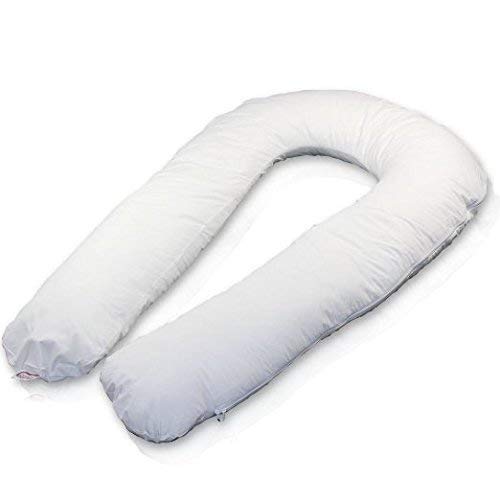
- Removable pillowcase
- Support for the whole body
- Odorless, hypoallergenic synthetic down
Price:
As well as normal pillows, we want to provide an option for those seeking more support. If you experience hip and back pain, for example, a body pillow will work wonders. Although this design will certainly take up more space in the bed than a standard pillow, it can save the effort of trying to hold two or three individual pillows in place (and then not being able to move until morning!).
The Moonlight Slumber Comfort-U Total Body Pillow is hypoallergenic made with a synthetic down, which is lightweight, dust mite resistant, and odorless. While holding shape, air can pass freely through the material, and this prevents overheating.
Wrapping around the body and supporting from behind, body pillows keep your hips aligned by threading between your legs. Even for pregnant women, the positioning between the legs provides additional support growing belly and strained hips.
You have the option to either wash the organic pillowcase or the whole pillow. However, even if you wash frequently, the Moonlight Slumber shouldn’t clump.
Sleep Innovations Contour Memory Foam Pillow Review
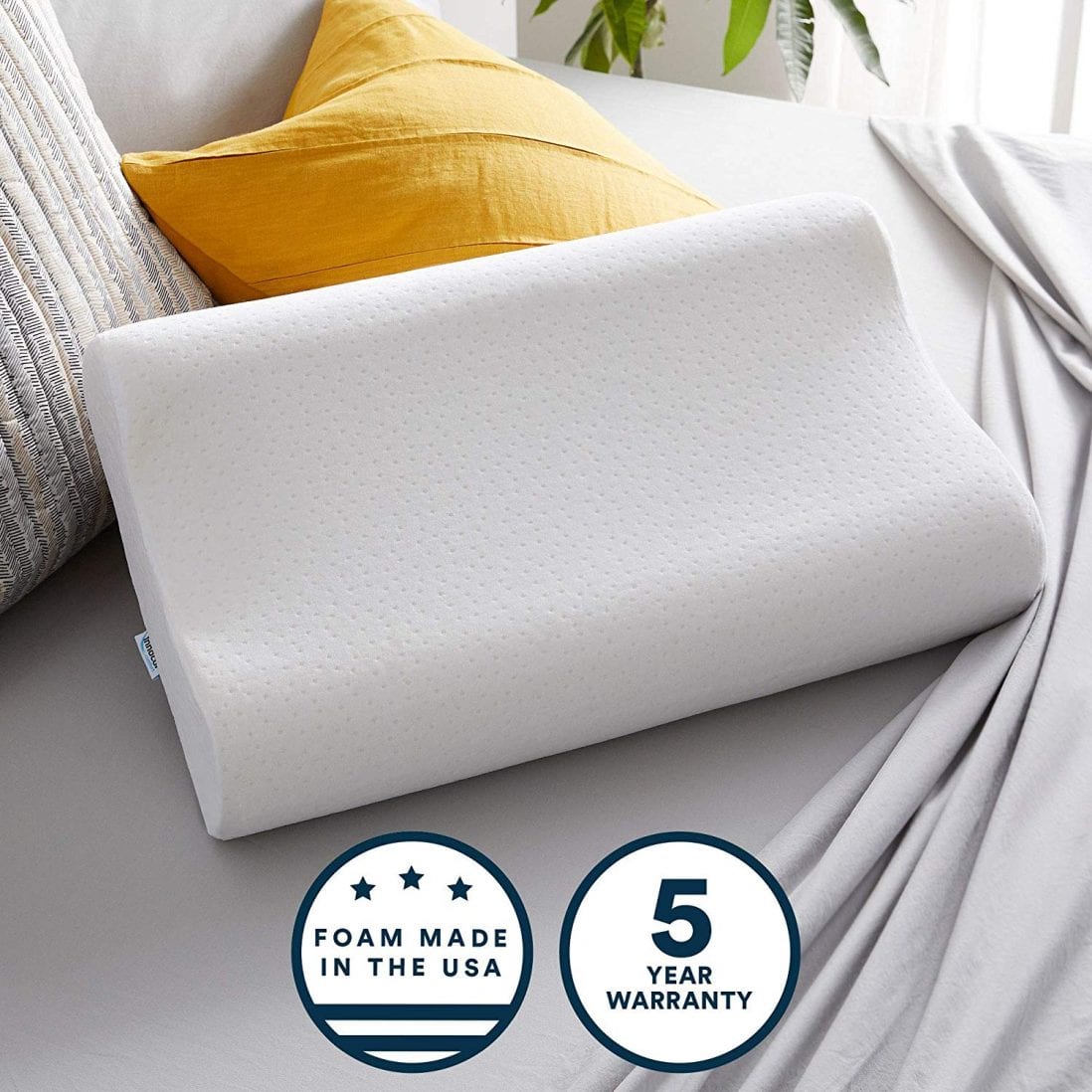
- Memory foam filling
- 100% cotton cover
- Cervical shape is perfect for back and side sleepers
Price:
Next up, we have a hypoallergenic pillow with an extra curve, and this provides added therapeutic support for the neck of back and side sleepers. Over the course of the night, all pressure and pain should be relieved while the neck, spine, and head remain aligned. Regardless of whether you choose the lower or higher contours, you should wake in the morning feeling refreshed.
With the memory foam filling, you have a material that is resistant to dust mites and naturally hypoallergenic. What’s more, the Sleep Innovations Contour Memory Foam Pillow should stay cool throughout the night since it’s moisture-wicking. Elsewhere, we love the fact that it comes with a zippered removable pillowcase and a replacement cover that are both machine washable; keep them on rotation, and your pillow will always stay fresh. Furthermore, the product has a five-year warranty and is made here in the US.
Utopia Bedding Gusseted Quilted Pillow (2-Pack) Review
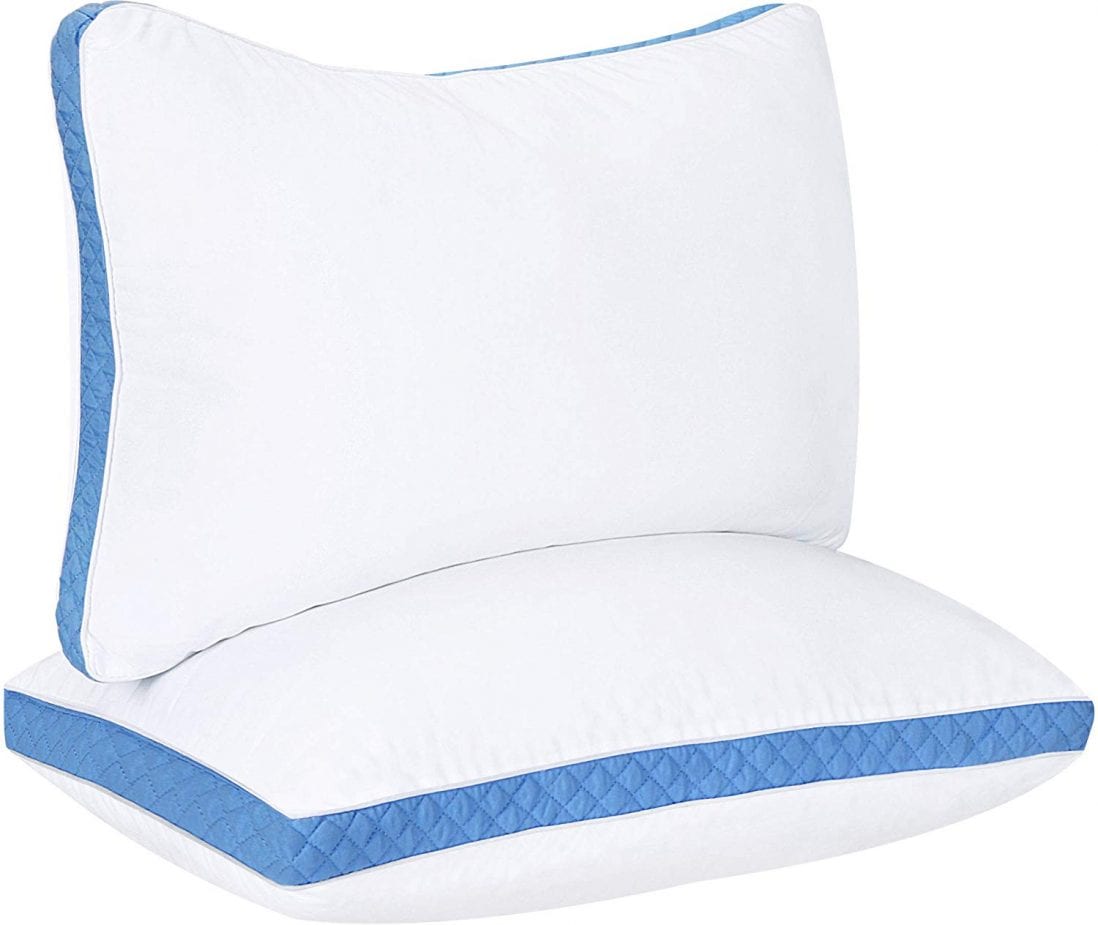
- Contains no harmful substances
- Durability with the gusseted design
- Comes in a set of two
Price:
Do you wear through pillows quite quickly? If so, we recommend one with a gusseted design because it has durability. With double stitching and extra fabric on the edges, it should be a reliable partner for many years. In particular, we recommend this Utopia Bedding Gusseted Quilted Pillow (2-Pack) because its plush medium-firm microfiber fill is breathable and can easily be shaped for perfect support.
Free from harsh chemicals, the product actually comes in a pack of two and suits back, side, and stomach sleepers. Why? Because they’re versatile in design. Whichever way you like to sleep, the pillow will suit your needs and provide comfort along the way.
When the Utopia Bedding Gusseted Quilted Pillow (2-Pack) first arrive, you might notice they’re somewhat flat, so we recommend a cycle through the dryer to fluff them up. You can hand wash or take them for a dry clean. As a last resort, you can use the washing machine, but this might reduce their life a little. Depending on your bed size, these hypoallergenic pillows come in King and Queen sizes.
Coop Home Goods Premium Adjustable Loft Pillow Review
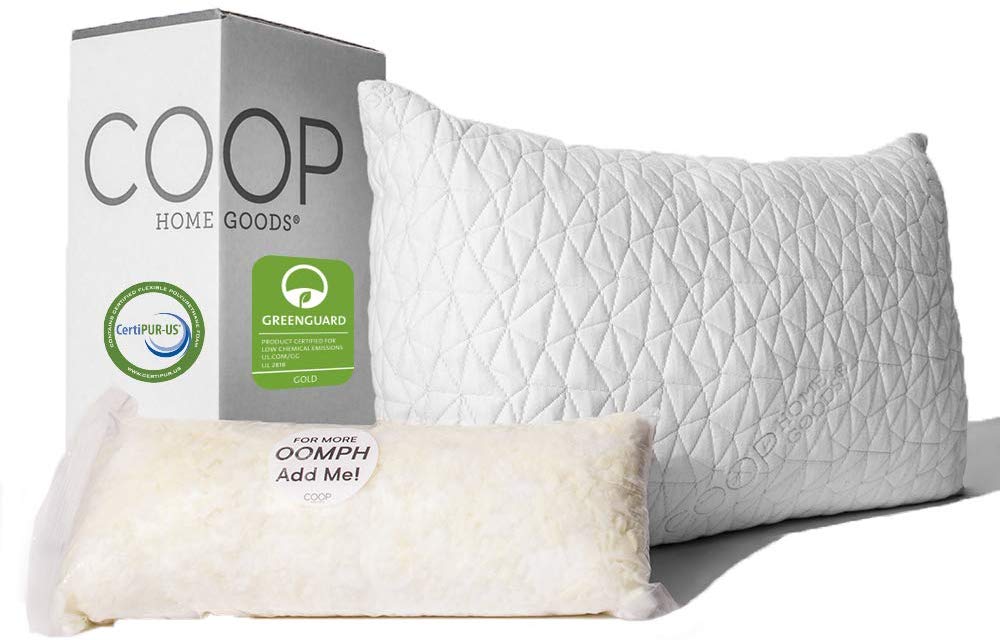
- Dust mite resistant and hypoallergenic
- Adjustable firmness and loft
- Machine washable cover
Price:
As our next hypoallergenic pillow choice, we have the Coop Home Goods Premium Adjustable Loft Pillow and one we love for the memory foam and microfiber combination. With the GREENGUARD and CertiPUR-US certifications, we can be confident in saying that it offers both support and comfort in a safe way. In fact, this breathable, lofty cushion masters the balance between firm support and soft contouring.
Of course, we’ve included the Coop Home Goods in our list for the adjustable loft. With the inner shell zipper, it takes seconds to add/remove filling for proper spinal support. In terms of shape, this is provided by the stretchy, lightweight liner that encases the foam and fiber filling.
Meanwhile, the pillowcase is made with a blend of polyester and bamboo-derived viscose-rayon; it’s actually Lulltra fabric, which is dust mite resistant and hypoallergenic. Since it’s a bamboo material, it’s also breathable and offers cold performance technology.
If you want to freshen up the Coop Home Goods Premium Adjustable Loft Pillow, take the case off and put it in a washing machine. Over time, you can also buy a replacement for the filling from the manufacturer directly. Whether you choose the king or queen size, it’s made in the US, comes with a 100-night sleep trial, and offers a five-year warranty. If you want a hypoallergenic body pillow, this is also available in the same style.
Sobakawa Traditional Buckwheat Pillow Review
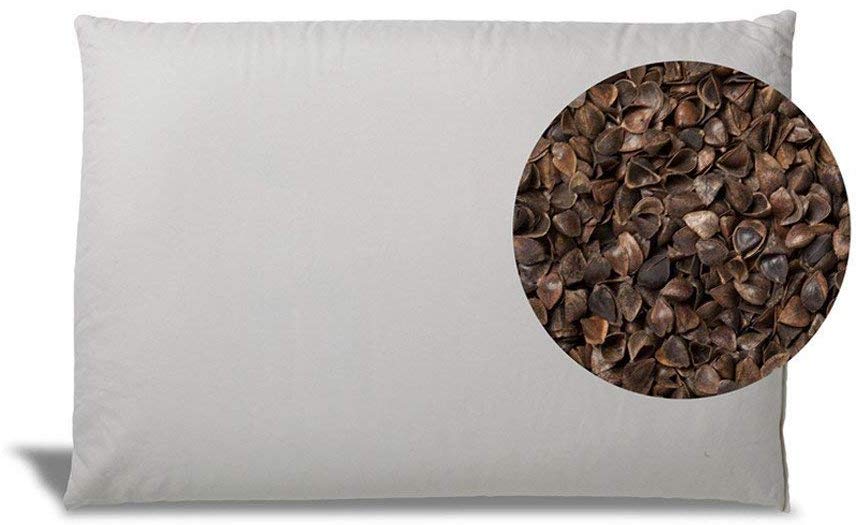
- Sleeps cool
- Great neck support
- Support for the hip
Price:
These Japanese pillows have been used in different parts of the world for some time, but Sobakawa is one of the first companies to bring it to the West. With a buckwheat hull design, the idea is to promote spinal alignment by keeping the neck and head in position. Simultaneously, pressure point relief should keep the airways open while also pushing to relieve tension, headaches, and migraines.
As well as being naturally airy, the hulls are hypoallergenic, and it all comes with a 100% cotton casing. This way, we get improved airflow and shaping for a comfortable sleep. When it comes to hypoallergenic pillows, this is a superb option, and the pliable design is only getting more popular.
Strictly speaking, the Sobakawa Traditional Buckwheat Pillow is not adjustable. However, there is an opportunity to play around and find what’s comfortable for you. With the firm support providing some give, we would recommend the Sobakawa for side and back sleepers.
Cause of Allergic Reactions and the Importance of Hypoallergenic Pillows
While some people experience allergic reactions and get watery eyes and a stuffy nose, others feel their airways swell and suffer anaphylactic shock. What’s more, some people have localized reactions and they come through as hives or rashes. There are some triggers more common than others, and they just so happen to be everywhere in the home;
- Dust mites
- Insect bites
- Pet dander
- Pollen
- Mold
- Household cleaners
- Some fabrics
When we experience reactions during the night, this suggests a problem with bedding. For example, it might be a buildup of moisture or dust/dander. Wherever possible, we recommend protective covers for your mattress. After this, make sure that all bedding is washed often to remove allergens collected in the seams and folds. With many hypoallergenic pillows, they can be washed in the machine for even more protection.
What’s a Hypoallergenic Pillow?
At this point of your research, we should provide a warning. Unfortunately, the term ‘hypoallergenic’ is NOT monitored. What does this mean? Well, manufacturers can describe their pillows as ‘hypoallergenic’ even if they are nowhere near as effective as other pillows in the niche. In the past, many people have been disappointed with their experience with hypoallergenic pillows, and this is why.
Generally speaking, the definition of a hypoallergenic pillow is that it doesn’t trigger allergies. Elsewhere, it can mean that the choice of material prevents a buildup of common allergens such as dust mites, mildew, and mold. The majority of hypoallergenic pillows will have one or several of the following;
- Improved Airflow - By boosting the circulation of air in a pillow, this can help fight off mildew spores, dust mites, and mold. As allergens struggle to settle, your sleeping experience improves. The best fill for airflow is considered to be between shredded memory foam and buckwheat hulls.
- Allergen Protection - With most pillows, the danger of allergens comes in the interior; with warmth and plenty of dead skin cells, it’s the perfect environment for allergens to survive. By using a cover or casing, this risk is reduced significantly. Using a tight weave in the design, allergens can’t get through this layer of protection.
- Anti-Allergen Treatment - Some pillows use materials that are actually allergen triggers, and this is common with feathers and down pillows. In this case, the allergens need to be removed with a special treatment technique.
- Antimicrobial Qualities - Finally, some materials are naturally microbial which helps to keep bacteria and allergens at bay. While latex and memory foam are the two biggest examples, it also includes covers made from rayon (bamboo) and linen.
Hypoallergenic Pillows - Your Options
Often, when people think of hypoallergenic pillows, they think they’re going to be pigeonholed into one or two materials and fillings. In reality, there are a number of different pillow types in this field. Here are your main options;
Buckwheat Hulls
As the shell casing of buckwheat seeds, it manages to retain shape while staying breathable (as it has no absorbent properties). There is a slight risk of buckwheat allergies, but the risk for other allergens is very small. Although dust mites and other allergens might get into the pillow, it’s naturally antibacterial and antimicrobial.
Natural Fibers
These days, cotton is the most popular option for natural materials in pillow cases. Not only is it soft (for a comfortable sleep), it’s light and breathable too. Elsewhere, similar benefits come from choosing linen. The reason cotton and linen are so successful is because it doesn’t take much for them to be woven into our choice of fabric.
Processed Materials and Fibers
While Tencel fibers are a by-product of wood fibers, bamboo fibers are a by-product of pulped bamboo. To break them down, there’s a chemical process and they’re then woven into a material blend. Preventing allergens from causing problems, the end result is a breathable and plush material. Often, covers using processed fibers and materials will be used alongside a hypoallergenic fill.
Latex
Here, we find another natural by-product and this time it’s from natural sap. In order to get the foam, soft surface we love, it goes through a number of processes. In terms of allergies, it’s possible to have an allergy to latex, but it’s very rare that the allergy-causing components are still present after the aforementioned processes. If you’re worried about your own allergy, have a conversation with your doctor.
Naturally, latex will block mildew spores and mold. On the other hand, dust mites can settle; one way to counteract this is to use shredded latex (the number of dust mites settling will reduce). What’s more, latex is also antimicrobial.
Feather/Down
Next up, it’s easy to get these two materials mixed up or assume they’re the same. In fact, feathers are the coarser outer plumage while down is much softer and comes from the inner plumage. Taken from geese and ducks, pillows with this material feel luxuriously comfortable but perhaps cause the biggest problems for people with allergies. As a result of the warmth, dust mites love to settle in down and feather pillows. Also, they can contain microbes while emitting dander. If you’re intent on choosing feather/down, make sure your selected pillow has been treated to remove contaminants.
Manmade Materials
We’ve seen examples of natural fibers and materials, but some manufacturers prefer to work with manmade materials, and polyester fibers are a great example. They prevent allergens from settling, provide support, and also have the potential to last for a long time. Thin threads are actually made from the synthetic resin which, in turn, are then used as a filling to be woven into a fabric blend.
Memory and Poly Foams
Although another manmade solution, these foams are actually naturally hypoallergenic. While some like a solid block on which to rest their head, others prefer the maneuverability of shredded foam. In fact, a small number of producers blend the foam with other materials for additional support. The two main benefits of memory foam are that it resists spores and is completely inedible for dust mites. This being said, dust mites are far more common in solid memory foam rather than shredded foam. Also, memory foam has the benefit of being antimicrobial.
Down Alternative
We’ve seen natural down, but did you know that some companies make a manmade alternative? To generate the same softness and airflow, the common choice is clusters of polyester puffballs. Of course, the great thing about alternatives is that the allergy issues simply don’t exist. On the flip side, additives and chemical treatments are required for antimicrobial properties and there’s also a risk of the fibrous texture attracting dust mites.
Buying Considerations for Hypoallergenic Pillows
In the past, we’ve seen people buy a pillow just because it was hypoallergenic. Of course, this is a terrible idea because there are many aspects to consider. As well as the hypoallergenic properties, you need support, comfort, and more. Therefore, we’ve included some buying considerations below.
Sleeping Position
Firstly, buying a pillow without thinking about your sleeping position would be a huge mistake. With the wrong pillow, the spine isn’t aligned properly, and this affects our ability to get restful sleep. Over time, we experience chronic pain, a disruption to our sleep, and even a loss of concentration at work. Here’s our advice for each position;
- Back Sleepers - Firstly, those on their back shouldn’t look for anything more than a single pillow. Without too much loft, it should leave the head in a natural position. If you want to fit the body, choose a flat surface with rounded edges. If you suffer lower back problems, put a wedge pillow under the knees and this will help relieve some of the pressure.
- Stomach Sleepers - Unfortunately, this is the position likely to cause the most problems because the spine is strained right from the beginning of the night. Therefore, we recommend a pillow under the hips to relieve some stress and get the natural alignment back. Try sleeping with no pillows; if you can’t sleep without pillows, choose a very thin one instead.
- Side Sleepers - If you don’t have a favorite side, we advise sleeping on the left because it puts the organs and whole body under less stress than the right. In terms of bedding, supportive pillows work between the knees and to support the back/stomach. For the head, a lofty pillow is best. With all three pillows in position, it’s possible to prevent twisting in the spine.
Sleeping Temperature
For some of us, it’s impossible to get through the night without getting hot and even sweating. Thankfully, most hypoallergenic materials also lend themselves to breathability, airflow, and cooling. However, you need to be careful with solid core foams. If you already sleep hot, the last thing you want is for your pillow to be storing this heat. If your heart is set on foam, look for a layer of gel or gel infusion.
Support and Comfort
As another consideration, you need the right support and comfort in the pillow you choose. With this in mind, take a look at firmness, loft, and the materials used on the cover. A pillow could be absolutely perfect in every single area, but it still won’t help you if you don’t find it comfortable.
Quality and Durability
Generally speaking, quality comes from a high thread count. If you haven’t seen this term before, it describes, per square inch, the number of fibers used. Assuming the threads themselves are of a good quality and aren’t too short, a high thread count is a positive feature. During your search, we recommend looking for pillows between 300 and 600. Often, quality breeds durability too, so don’t be afraid to spend a little more if it means getting a pillow that is reliable and will offer a long life.
Other Considerations
To keep your bed clean and smelling fresh, you could look for a pillow that can go in the machine (this would make everything easier!). Elsewhere, other considerations include breathability and cooling technologies. Also, does the company offer a strong warranty on the product or do they have a satisfaction guarantee? When pillows have a money-back guarantee and a warranty in case something goes wrong, it takes all the risk out of the purchase.
Tips and Advice for Hypoallergenic Pillows
Before we finish on some frequently asked questions, here’s some more advice and tips regarding hypoallergenic pillows.
- To extend the life of your pillow, keep it clean. If possible, clean the cover as well as the pillow itself. If you want to produce allergens, make sure you wash above 55 degrees. If a hot wash isn’t an option, use a product that kills dust mites and other allergens; important ingredients include tea tree oil and/or eucalyptus oil. When using a new product, read the manufacturer’s instructions and take care.
- If you want to reduce the risk of experiencing dust mites, keep your room cool and lower the humidity. If humidity is kept below 30%, dust mites are incredibly unlikely.
- If you have eczema or asthma, you’ll get additional protection from a dust mite-proof case. However, there is a trade-off that comes with this purchase; these covers can restrict airflow and cause heat retention.
- Have you ever considered things other than bedding to improve your sleeping and allergy experience? Well, many others have, and they strongly believe in aromatherapy. As you start using essential oils, you might see a reduction in allergy symptoms.
- This might sound simple, but you won’t believe how effective it is to keep pets from your bedroom. If you’re serious about keeping dust mites and dander away from bedding, preventing pets from entering the room needs to be a starting point.
- As well as inside causes, allergens can come in from outside so this is another area of concern. Can you keep bedroom windows closed? Even with screens covering your windows, the microscopic mildew/mold spores and dust mites will still enter.
- Sometimes, it’s not all about cleaning products and extensive washing procedures, it’s a case of allowing bedding to air out. With direct sunlight beaming onto the bedding, allergens are eradicated, and you get clean pillowcases. Try doing this twice per year.
Frequently Asked Questions
Am I allergic to my pillow?
While we can’t answer this for you today, we can suggest you see a doctor with any problems. Do you wake up with sticky or itchy eyes? Do you feel like you’ve had a cold for weeks or months without improvement? It could be that your bedding is causing the problems.
Will washing remove dust mites?
Yes. If you can’t put the pillow in the machine, we recommend 15 minutes in the dryer. As long as it’s above 130 degrees Fahrenheit, the dust mites will go. You can even wash and dry by hand to remove other allergens.
Do I need to replace my pillow?
It all depends on the material and when you bought it. For cheap polyester, we recommend a new one every six months or so. If you already have a hypoallergenic pillow with higher-quality materials, it will last a little longer. For example, memory foam, latex foam, and bamboo fiber tend to have the longest life.
Thanks for Reading
There we have it, everything you need to know about hypoallergenic pillows. As long as you remember the buying considerations and put yourself first, you’ll soon find a pillow that offers support, comfort, durability, and help for your allergies. As well as hypoallergenic materials, results also come with airflow, breathability, and less dense fillings.
Once you have your pillow and you’re happy with it, keep it clean and take care of all your bedding as one. Even with the best hypoallergenic pillows, they won’t last long without care. Keep researching, find a pillow that matches your needs, and why not start with a product listed in the first section today?



